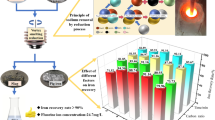Abstract
Red mud and waste cathode carbon block are two major solid wastes of the aluminum industry. In this study, an innovative method has been proposed for co-treatment of red mud and spent cathode carbon block to reuse carbon and recover iron by melting reduction. The effects of parameters such as temperature, alkalinity, reaction time, and the CaF2 addition on the process were investigated. According to the experiment, the suitable reaction conditions were the reduction temperature of 1350 ℃, the alkalinity of 1.0, the reaction time of 30 min, and the optimal CaF2 addition was 10 g. The Fe recovery rate was 91.60% which can be directly used for electric furnace steelmaking. This work should help to improve the future large-scale, high-value, and zero waste utilization of red mud. It was also of great significance for the harmless treatment of spent cathode carbon blocks and alleviating the shortage of iron ore resources in China.
Access this chapter
Tax calculation will be finalised at checkout
Purchases are for personal use only
Similar content being viewed by others
References
Erçağ, E, Apak, R (1997) Furnace smelting and extractive metallurgy of red mud: Recovery of TiO2, Al2O3 and pig iron. J. J Chem Technol Biot. 70(3):241–246.
Liu, ZH B, Li, H X (2015) Metallurgical process for valuable elements recovery from red mud—A review. J. Hydrometallurgy. 155:29–43.
Jayasankar, K, Ray, P K, Chaubey, A K, Padhi, A, Satapathy, B K, Mukherjee, P S (2012) Production of pig iron from red mud waste fines using thermal plasma technology. J. Int J Min Met Mater. 19(08):679–684.
Klauber, C, Gräfe, M, Power, G (2011) Bauxite residue issues: II. options for residue utilization. J. Hydrometallurgy. 108(1):11–32.
Menzies, N W, Fulton, I M, Morrell, W J (2004) Seawater Neutralization of Alkaline Bauxite Residue and Implications for Revegetation. J. J Environ Qual.33(5):1877–1884.
Stefan, R, Jelle, M, Elvira, V, Boris, D, André, P, Erik, S (2011) The red mud accident in Ajka (Hungary): plant toxicity and trace metal bioavailability in red mud contaminated soil. J. Environ Sci Technol.45(4):1616–1622.
Borra, C R, Pontikes, Y, Binnemans, K, Gerven, T V (2015) Leaching of rare earths from bauxite residue (red mud). J. Miner Eng. 76:20–27.
Liu, Y T, Qin, ZH H, Chen, B (2020) Experimental research on magnesium phosphate cements modified by red mud. J. Constr Build Mater. 231:117–131.
LÜ, C S, Wang, J W, Jia Y Z (2013) Effects of red mud content on the sintered red mud bricks. J. Journal of Safety and Environment. 13:98–102.
Grafe, M, Power, G, Klauber, C (2011) Bauxite residue issues: III. Alkalinity and associated chemistry. J. Hydrometallurgy. 108:60–79.
Sadangi, J K, Das, S P, Tripathy, A (2018) Investigation into recovery of iron values from red mud dumps. J. Sep Sci Technol. 53:1–6.
Khairul, M A, Zanganeh, J, Moghtaderi, B (2019) The composition, recycling and utilisation of Bayer red mud. J. Resour Conserv Recy. 141:483–498.
Li Y, Wang J, Wang X (2011) Feasibility study of iron mineral separation from red mud by high gradient superconducting magnetic separation. J. Physica C.471(3/4):91–96.
Pepper, R A, Couperthwaite, S J, Millar, G J (2016) Comprehensive examination of acid leaching behaviour of mineral phases from red mud: Recovery of Fe, Al, Ti and Si. J. Miner Eng. 99:8–18.
Samouhos, M, Taxiarchou, M, Pilatos, G (2017) Controlled reduction of red mud by H2 followed by magnetic separation. J. Miner Eng. 105:36–43.
Gostu, S, Mishra, B, Martin, GP (2017) Low temperature reduction of hematite in red mud to magnetite. In: Light Metals 2017, pp 67–73.
Li, X B, Xiao, W, Liu, W, Liu, G H, Peng, Z H, Zhou, Q S, Qi, T G (2009) Recovery of alumina and ferric oxide from Bayer red mud rich in iron by reduction sintering. J. Trans. Nonferrous Met. Soc. China.19(5):1342–1347.
Wang, K, Liu, Y, Zhang, T A, Li, X F, Chen, X (2020) Investigation of the smelting reduction mechanism and of iron extraction from high-iron red mud. J. Mater. Res. Express 7. 126514.
Samouhos, M, Taxiarchou, M, Tsakiridis, P E (2013) Greek “red mud” residue: a study of microwave reductive roasting followed by magnetic separation for a metallic iron recovery process. J. J Hazard Mater. 254/255:193–205.
Lu, F H, Su, X D, Huang, F, Wang, J W, Wang, H F (2020) Co-Treatment of Spent Pot-Lining and Red Mud for Carbon Reutilization and Recovery of Iron, Aluminum and Sodium by Reductive Roasting Process. Metall Mater Trans B.51:1564–1575.
Byers, R L (1982) Disposal of Spent Pot-lining Research and Development. J. Light Metals. 1023–1030.
Acknowledgements
This work was supported by the National Natural Science Foundation of China (U1710257, U1702253, U1903129) Key Technologies Research and Development Program [2017YFC0210404, 2017YFC0210403-04].
Author information
Authors and Affiliations
Corresponding author
Editor information
Editors and Affiliations
Rights and permissions
Copyright information
© 2022 The Minerals, Metals & Materials Society
About this paper
Cite this paper
Li, X., Zhang, T., Wang, K., Lyu, G., Chen, X. (2022). Recovery of Iron from High-Iron Bayer Red Mud by Melting Reduction with Spent Cathode Carbon Block. In: Eskin, D. (eds) Light Metals 2022. The Minerals, Metals & Materials Series. Springer, Cham. https://doi.org/10.1007/978-3-030-92529-1_8
Download citation
DOI: https://doi.org/10.1007/978-3-030-92529-1_8
Published:
Publisher Name: Springer, Cham
Print ISBN: 978-3-030-92528-4
Online ISBN: 978-3-030-92529-1
eBook Packages: Chemistry and Materials ScienceChemistry and Material Science (R0)




